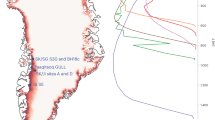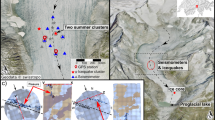Abstract
Patterns of subsurface wedges of ice that form along cooling-induced tension fractures, expressed at the ground surface by ridges or troughs spaced 10–30 m apart, are ubiquitous in polar lowlands1. Fossilized ice wedges, which are widespread at lower latitudes, have been used to infer the duration2,3,4 and mean temperature5,6 of cold periods within Proterozoic2 and Quaternary climates3,4,5,6,7,8,9,10,11,12,13, and recent climate trends have been inferred from fracture frequency in active ice wedges14. Here we present simulations from a numerical model for the evolution of ice-wedge networks over a range of climate scenarios, based on the interactions between thermal tensile stress, fracture and ice wedges. We find that short-lived periods of severe cooling permanently alter the spacing between ice wedges as well as their fracture frequency. This affects the rate at which the widths of ice wedges increase as well as the network's response to subsequent climate change. We conclude that wedge spacing and width in ice-wedge networks mainly reflect infrequent episodes of rapidly falling ground temperatures rather than mean conditions.
This is a preview of subscription content, access via your institution
Access options
Subscribe to this journal
Receive 51 print issues and online access
$199.00 per year
only $3.90 per issue
Buy this article
- Purchase on Springer Link
- Instant access to full article PDF
Prices may be subject to local taxes which are calculated during checkout



Similar content being viewed by others
References
French, H. M. The Periglacial Environment (Addison Wesley, Harlow, 1996)
Williams, G. E. et al. in Earth's Glacial Record (eds Deynoux, M. et al.) 146–164 (Cambridge Univ. Press, Cambridge, 1994)
Black, R. F. in Glacial Geomorphology (ed. Coates, D.) 247–275 (State Univ. New York, Binghamton, 1974)
Johnson, W. H. Ice-wedge casts and relic patterned ground in central Illinois and their environmental significance. Quat. Res. 33, 51–72 (1990)
Renssen, H. & Isarin, R. F. B. The two major warming phases of the last deglaciation at ∼14.7 and ∼11.5 ka cal BP in Europe: climate reconstructions and AGCM experiments. Glob. Planet. Change 30, 117–153 (2001)
Isarin, R. F. B. Permafrost distribution and temperatures in Europe during the Younger Dryas. Permafrost Periglac. Process 8, 313–333 (1997)
Maizels, J. K. Frequency of relic frost-fissure structures and prediction of polygon pattern: A quantitative approach. Biul. Peryglac. 30, 67–89 (1986)
Walters, J. C. Ice-wedge casts and relict polygonal patterned ground in North-East Iowa, USA. Permafrost Periglac. Process 5, 269–282 (1994)
Owen, L. A. et al. Relic permafrost structures in the Gobi of Mongolia: age and significance. J. Quat. Sci. 13, 539–547 (1998)
Pewe, T. L. Proc 1st Int. Permafrost Conf. 76–81 (Publication 1287, National Academy of Science and National Research Council, Washington DC, 1966)
Black, R. F. Periglacial features indicative of permafrost: Ice and soil wedges. Quat. Res. 6, 3–26 (1976)
Borns, H. W. Late glacial ice-wedge casts in northern Nova Scotia, Canada. Science 148, 1223–1226 (1965)
Grosso, S. A. & Corte, A. E. Pleistocene ice wedge casts at 34 degrees S; Eastern Andes piedmont, south-west of South America. Geogr. Ann. A 71, 125–136 (1989)
Kasper, J. N. & Allard, M. Late-Holocene climatic changes as detected by the growth and decay of ice wedges on the southern shore of Hudson Strait, northern Québec, Canada. Holocene 11, 563–577 (2001)
Lachenbruch, A. H. Mechanics of thermal contraction cracks and ice-wedge polygons in permafrost. Spec. Pap. Geol. Soc. Am. 70 (1962)
Mackay, J. R. The first seven years (1978-1985) of ice-wedge growth; Illisarvik experimental drained lake site, western Arctic coast. Can. J. Earth Sci. 23, 1782–1795 (1986)
Mackay, J. R. Air temperature, snow cover, creep of frozen ground, and the time of ice-wedge cracking, western Arctic coast. Can. J. Earth Sci. 30, 1720–1729 (1993)
Mackay, J. R. The frequency of ice-wedge cracking (1967–1987) at Garry Island, western Arctic coast, Canada. Can. J. Earth Sci. 29, 236–248 (1992)
Plug, L. J. & Werner, B. T. Fracture networks in frozen ground. J. Geophys. Res. 106, 8599–8613 (2001)
Werner, B. T. Complexity in natural landform patterns. Science 284, 102–104 (1999)
Nicolis, G. & Prigogine, I. Self-organization in Nonequilibrium Systems (Wiley, New York, 1977)
Hopkins, D. M. Thaw lakes and thaw sinks in the Imuruk Lake area, Seward Peninsula Alaska. J. Geol. 57, 119–131 (1949)
Zhu, Y. & Carbee, D. L. Tensile Strength of Frozen Silt Report 87-14 (Army Cold Regions Research and Engineering Laboratory, Hannover, New Hampshire, 1987)
Gold, L. W. Engineering properties of freshwater ice. J. Glaciol. 19, 197–212 (1977)
Goodman, D. J. & Tabor, D. Fracture toughness of ice: An account of some new experiments. J. Glaciol. 21, 651–660 (1978)
Hanks, T. C., Bucknam, R. C., Lajoie, K. R. & Wallace, R. E. Modification of wave-cut and faulting controlled landforms. J. Geophys. Res. 89, 5771–5790 (1984)
Acknowledgements
We thank R. Anderson and B. Hallet for reviews, and the late D.M. Hopkins for comments on an earlier version. This work was supported by the NSF, Arctic Natural Sciences Program, the Andrew W. Mellon Foundation, and the National Park Service, Bering Land Bridge National Preserve.
Author information
Authors and Affiliations
Corresponding author
Ethics declarations
Competing interests
The authors declare that they have no competing financial interests.
Rights and permissions
About this article
Cite this article
Plug, L., Werner, B. Nonlinear dynamics of ice-wedge networks and resulting sensitivity to severe cooling events. Nature 417, 929–933 (2002). https://doi.org/10.1038/nature00796
Received:
Accepted:
Issue Date:
DOI: https://doi.org/10.1038/nature00796
This article is cited by
-
Recognition of geological processes in permafrost conditions
Bulletin of Engineering Geology and the Environment (2019)
Comments
By submitting a comment you agree to abide by our Terms and Community Guidelines. If you find something abusive or that does not comply with our terms or guidelines please flag it as inappropriate.



